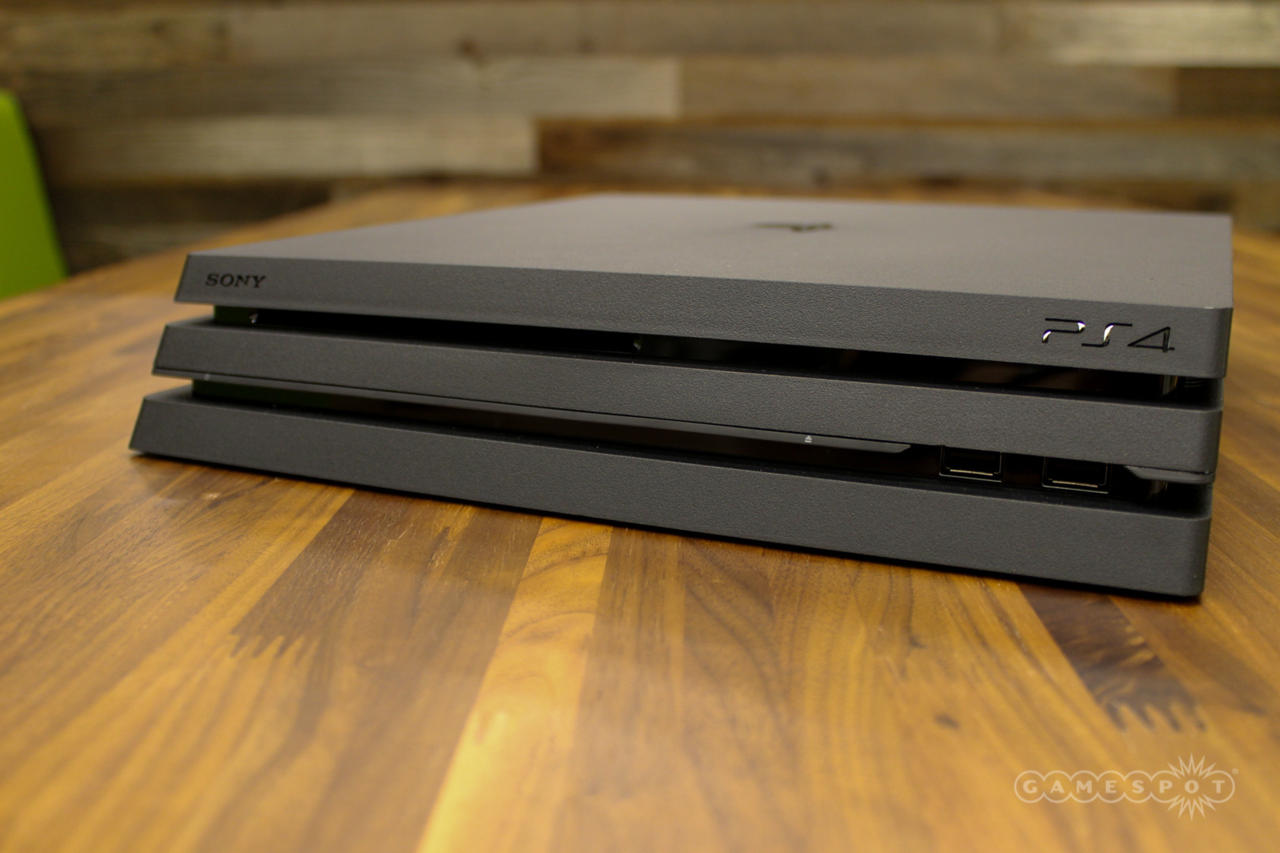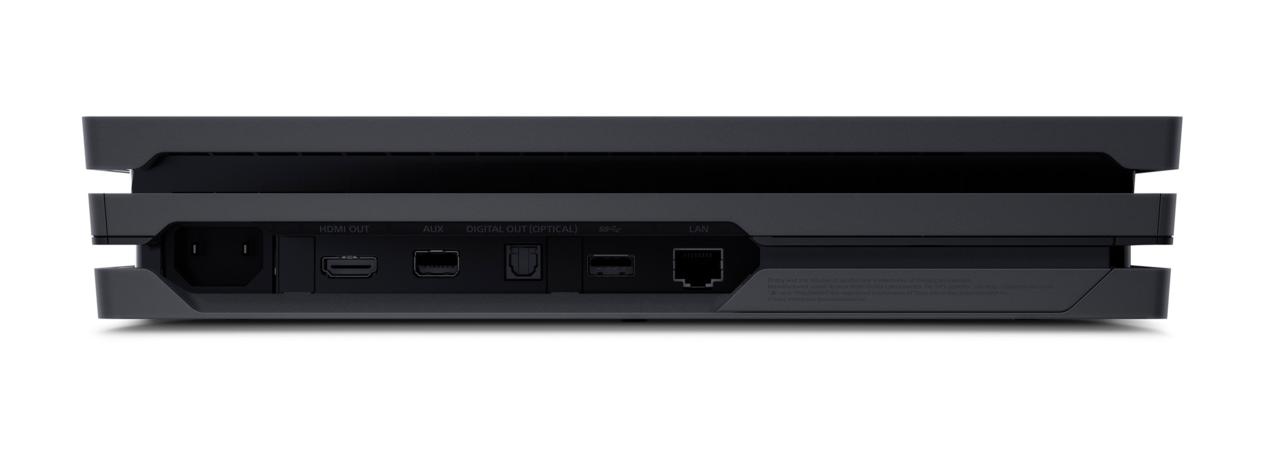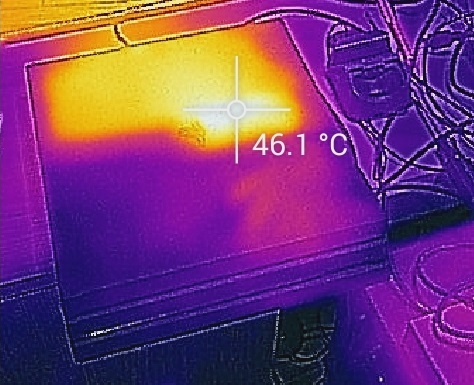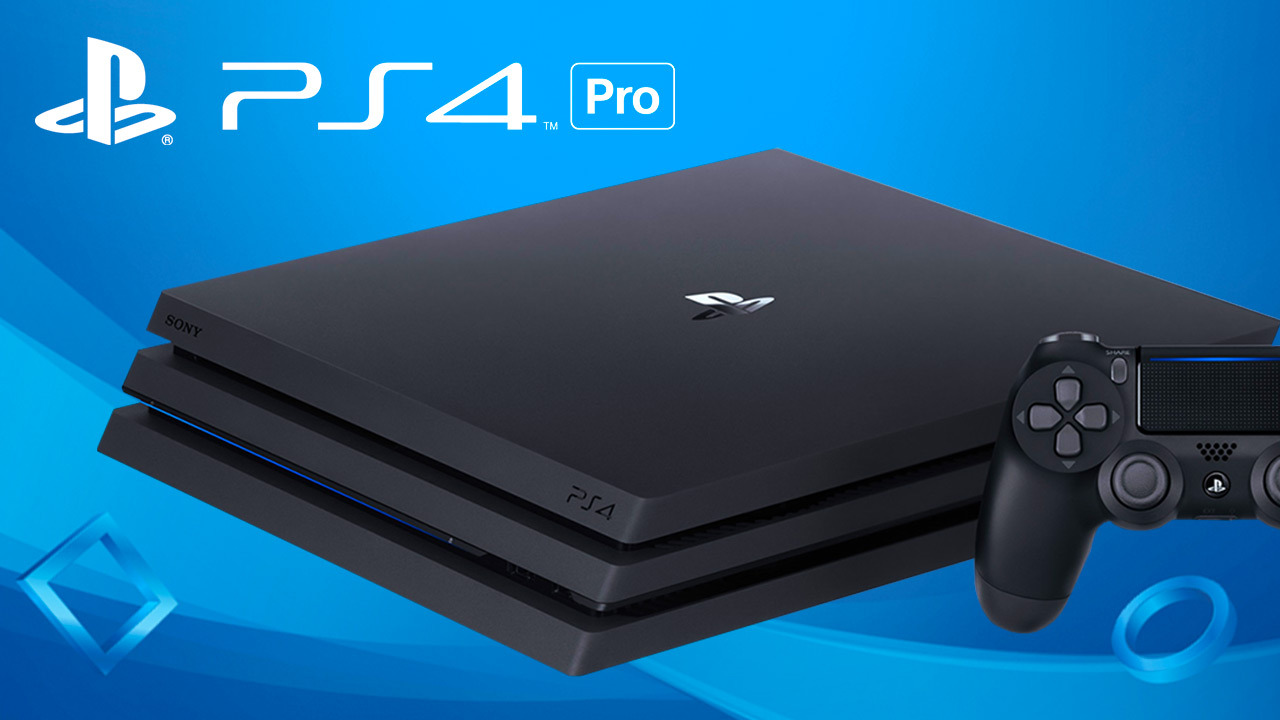Update: This is our PS4 Pro review. For more information on the PS4 Slim, check out our coverage here. Related: Console Specs Compared.
The PlayStation 4 Pro represents a new move for Sony. While the company has refreshed many of its consoles before, the PS4 Pro marks the first time a mid-generational design has received a significant boost in processing power. Sony says that the Pro was primarily designed to take advantage of burgeoning 4K TVs, but is it powerful enough? More importantly, is it worth it? Let’s find out.
What’s in the Box?
Before I dive into the PS4 Pro’s tech specs, let’s take a look at what comes inside the box. Aside from the console, the package includes a mono headset, HDMI cable, DualShock 4 controller, USB charging cable, and an AC power cord. The PS4 Pro uses a thicker, two-pronged power cable this time around and measures about 60 inches in length. This is roughly 20 inches shorter than the PS4 Slim’s equivalent.
STAR WARS: Prequel Pack - Official Reveal Trailer DEAD OR ALIVE Xtreme Venus Vacation PRISM - Official 2nd Trailer Phantom Blade Zero - 6 Minute "Year of the Snake" Gameplay Trailer The Hundred Line -Last Defense Academy-: Character Trailer 1 Black Ops 6 & Warzone - Official Season 02 Launch Trailer GUILTY GEAR STRIVE: DUAL RULERS - Official Main Trailer Marvel Rivals | The Spring Festival Trailer Kingdom Come: Deliverance 2 Roadmap Trailer Zenless Zone Zero - Astra Yao Character Demo | "Ridu Holidays" BlazBlue Entropy Effect - Hazama Character DLC Gameplay Reveal Trailer Helskate Launch Trailer Code Violet | Announcement Trailer
Please enter your date of birth to view this video
By clicking 'enter', you agree to GameSpot's
Terms of Use and Privacy Policy
Design
One of the first things you’ll notice about the PS4 Pro is that its 11.6x2.1x12-inches chassis is big. At 7.2 pounds, it’s also quite heavy. In terms of aesthetics, it maintains the PlayStation 4’s slanted design but opts to use the PS4 Slim's more rounded corners as opposed to the original model’s sharper edges. It also uses the Slim’s matte black finish. The console has a new power LED light bar on the front, which starts on the left and trails off to the right. Coupled with the light bar are physical power and eject buttons.

The Pro sort of looks like a PS4 Slim stacked on top of the original PS4, and it has two slits that go around the chassis. The optical drive is located on the top slit, and speaking of it, despite being a 4K-capable system, the Pro doesn’t support 4K Blu-ray discs. This is an odd, unfortunate omission, which slightly detracts from the package. Luckily, the PS4 Pro will be able to stream 4K HDR video from apps like Netflix and YouTube.
One of the first things you’ll notice about the PS4 Pro is that its 11.6x2.1x12-inches chassis is big.
In terms of ports, the Pro brings back the optical S/PDIF, which was removed from the PS4 Slim. In addition to the two USB 3.1 ports on the front, the Pro offers a third USB 3.1 port on the back, which pairs well with PlayStation VR, since the separately available headset takes up a port. Other inputs on the back include HDMI, AUX, and Ethernet. The Pro also exhausts heat through vents on the back.

Like the original PS4 and PS4 Slim before it, the Pro model has an integrated power supply, which saves you the trouble of figuring out where to position a bulky external power brick. On top of the unit is a reflective silver PlayStation logo, and tucked underneath the console are little rubber feet modeled after the PlayStation button logos.
The Pro doesn’t support 4K Blu-ray discs. This is an odd, unfortunate omission.
Specs
Underneath the hood, the PlayStation 4 Pro features the following tech specs:
- CPU: x86-64 AMD "Jaguar," 8 cores clocked at 2.1GHz
- GPU: 4.2 TFLOPS, AMD Radeon-based graphics clocked at 911MHz with 36 compute units
- Memory: GDDR5 8GB + 1GB DRAM
- Storage size: 1TB hard drive
- External dimensions: Approx. 295x55x327 mm/11.6x2.1x12.8 in (width x height x length)
- Blu-ray/DVD Drive: Blu-ray × 6 CAV, DVD × 8 CAV
- Input/Output: Super-Speed USB (USB 3.1 Gen.1) port × 3, AUX port × 1
- Networking: Ethernet (10BASE-T, 100BASE-TX, 1000BASE-T)×1, IEEE 802.11 a/b/g/n/ac, Bluetooth 4.0 (LE)
- Power: AC 100V, 50/60Hz
- Power consumption: Max. 310W
- AV Output: HDMI out port (supports 4K/HDR), optical port
The faster graphics processing unit is arguably the most significant boost the PS4 Pro offers. The GPU is based on AMD’s new Polaris microarchitecture, which the graphics-card manufacturer debuted with its Radeon RX 480 GPU. Its 911MHz frequency is 14 percent higher than the original model's equivalent. It also offers twice the number of compute units with 36 CUs and features 4.2 teraflops of performance, which is 2.28 times as much as the original PS4.
STAR WARS: Prequel Pack - Official Reveal Trailer DEAD OR ALIVE Xtreme Venus Vacation PRISM - Official 2nd Trailer Phantom Blade Zero - 6 Minute "Year of the Snake" Gameplay Trailer The Hundred Line -Last Defense Academy-: Character Trailer 1 Black Ops 6 & Warzone - Official Season 02 Launch Trailer GUILTY GEAR STRIVE: DUAL RULERS - Official Main Trailer Marvel Rivals | The Spring Festival Trailer Kingdom Come: Deliverance 2 Roadmap Trailer Zenless Zone Zero - Astra Yao Character Demo | "Ridu Holidays" BlazBlue Entropy Effect - Hazama Character DLC Gameplay Reveal Trailer Helskate Launch Trailer Code Violet | Announcement Trailer
Please enter your date of birth to view this video
By clicking 'enter', you agree to GameSpot's
Terms of Use and Privacy Policy
The console itself still offers 8GB of GDDR5 memory, which it shares with the CPU, but Sony has also added 1GB of DRAM for the CPU. This allows the x86-based processor to run the operating system and streaming video applications at 4K. This extra DRAM also frees up some of the faster GDDR5 memory for the GPU.
The CPU is still an eight-core Jaguar AMD processor, but its frequency has been raised from 1.6GHz to 2.1GHz, which amounts to a 31 percent boost.
The PS4 Pro also comes with a larger 1TB hard drive--though it’s unfortunately still the slower 5,400rpm variety as opposed to the slightly faster 7,200rpm equivalent. Luckily, you can still swap out the HDD for a solid-state drive, and because the Pro supports the SATA III interface, SSDs installed in the console can now reach up to 6Gbps speeds. This is double the frequency of the original PS4’s SATA II interface.
Graphical Enhancements
The main reason to get excited about the PS4 Pro is the prospect of better graphics. The new console is completely backward-compatible with the existing library of PS4 games, and some titles will receive graphical enhancements on the Pro. Some games may use the extra processing power to bolster frame rates, while others may render at a higher resolution. Some games may run natively at 4K, but Sony says the majority of games will use a 4K upscaling technique the company calls checkerboard rendering, essentially a 4K rendering shortcut that isn’t as taxing on hardware. It’s not quite as sharp as native 4K, but it does look surprisingly close.
STAR WARS: Prequel Pack - Official Reveal Trailer DEAD OR ALIVE Xtreme Venus Vacation PRISM - Official 2nd Trailer Phantom Blade Zero - 6 Minute "Year of the Snake" Gameplay Trailer The Hundred Line -Last Defense Academy-: Character Trailer 1 Black Ops 6 & Warzone - Official Season 02 Launch Trailer GUILTY GEAR STRIVE: DUAL RULERS - Official Main Trailer Marvel Rivals | The Spring Festival Trailer Kingdom Come: Deliverance 2 Roadmap Trailer Zenless Zone Zero - Astra Yao Character Demo | "Ridu Holidays" BlazBlue Entropy Effect - Hazama Character DLC Gameplay Reveal Trailer Helskate Launch Trailer Code Violet | Announcement Trailer
Please enter your date of birth to view this video
By clicking 'enter', you agree to GameSpot's
Terms of Use and Privacy Policy
Checkerboard rendering is not quite as sharp as native 4K, but it does look surprisingly close.
PS4 games will not receive Pro enhancements out of the box, however. Developers will have to patch their games to take advantage of the Pro’s extra processing power. Sony asserts that patching a title to implement checkerboard rendering isn’t too time-intensive, but it’s unclear how many titles will support the upscaling technique moving forward, since Sony doesn’t require developers to implement the feature. Developers can actually use the extra power as they see fit. Instead of cranking up the resolution, developers may choose to increase graphical fidelity, offer improved frame rates, or use better anti-aliasing techniques. This means the Pro could bolster visuals at 1080p. Middle-earth: Shadow of Mordor, for instance, uses super-sampling anti-aliasing to mitigate jaggy edges on regular HD displays.
Visual Analysis
To analyze the visual enhancements that the PS4 Pro offers, I compared it against a PS4 Slim. The Slim replaces the original PS4, and while it might look a little different from the 2013 model, it carries the same GPU and CPU horsepower.
I hooked up both PlayStations to different HDMI inputs on the same TV: a 55-inch 4K high-dynamic range (HDR) display. I gathered two copies of every PS4 Pro-enhanced game that I could get copies of and quickly switched between the two inputs to conduct visual A/B tests. Both HDMI inputs were calibrated to look exactly the same. Because the PS4 Pro can also bolster 1080p graphics, I also connected both systems to a 55-inch 1080p TV and similarly analyzed the visual differences there.
While the PS4 Pro will support 4K HDR video streaming via apps like Netflix and Youtube, 4K HDR versions of these PlayStation apps won’t release until the console launches on November 10. At the time of this writing, only a handful of games support PS4 Pro enhancements. The games I tested included Call of Duty: Modern Warfare Remastered, Call of Duty: Infinite Warfare, Middle-earth: Shadow of Mordor, The Last of Us, Call of Duty: Black Ops III, and Infamous: Second Son.
Call of Duty: Modern Warfare Remastered
You sometimes have to stand still and look for these visual differences, since they aren't huge graphical improvements, but the main takeaway here is that the PS4 Pro offers a clearer image overall.
With both PlayStations hooked up to the 4K TV, I noticed that the Pro offered slightly better textures in the remastered version of Modern Warfare. The Pro made it a bit easier to make out the individual hair follicles on an NPC’s beard, for instance. The Pro also allows the game to support a dynamic resolution that scales up to 4K, which helps mitigate some aliasing issues. Flickering fences on the Slim looked clean and stable on the Pro, for instance. Text on distant posters strewn about the game’s opening training area were also unreadable on the Slim, but were legible on the Pro. You sometimes have to stand still and look for these visual differences, since they aren't huge graphical improvements, but the main takeaway here is that the PS4 Pro offers a clearer image overall.
When I hooked up both consoles to our 1080p TV, I couldn’t tell much of a difference, unfortunately. Since the PS4 Slim already runs the game at 60 frames per second, it’s already hitting the TV’s 60Hz refresh rate limit, so I wasn’t able to gauge any frame-rate improvements.
Call of Duty: Infinite Warfare
With both systems hooked up to the 4K TV, I noticed slightly richer textures on the Pro. For instance, I could more easily see fibrous textures on clothing. The game also has better anti-aliasing with edges that look less pixelated. They’re not huge improvements, but the Pro once again offers more clarity and less noise than the Slim on the 4K TV.
When I hooked up both systems to our 1080p TV, I was able to see better AA and slightly sharper textures from the Pro, but they weren’t as noticeable at this resolution.
Middle-earth: Shadow of Mordor
Shadow of Mordor offers different graphical enhancement options with the Pro. One option allows you to favor resolution. This dynamically scales the game’s resolution up to 4K and smooths out unwanted jaggies. Once again, the Pro’s video quality looked clearer at 4K as a result.
When the Pro runs Shadow of Mordor on a 1080p TV with resolution favored, it switches to a super-sampling anti-aliasing mode to render the game at a higher-than-1080p resolution and then shrinks the image down to 1080p. This does a decent job of making a regular HD display appear sharper than it actually is.
Alternatively, Shadow of Mordor also has a setting that allows you to favor quality. This forces the game to run at 1080p, regardless of the display, but it increases graphical fidelity. Unfortunately, outside of extra wrinkles on faces, I couldn’t notice any other visual enhancements.
The Last of Us
The Last of Us has been updated to support HDR, and while the original PS4 and PS4 Slim models now support HDR via a recent firmware update, the PS4 Pro still made the game’s colors look much richer and lusher.
As the game opens, it takes place in a dimly lit bedroom at night. Playing the game on the PS4 Pro, you can clearly see a green poster on one of the walls with legible words written on it. On the Slim, it’s hard to even see the green poster, let alone the words--it's completely blanketed in darkness.
The Pro made the game’s colors look much richer and lusher.
Textures also look much sharper with the Pro. For instance, the small text on book spines is easily readable, whereas it looks like illegible smudge stains on the Slim. The Pro also offers slightly better anti-aliasing; characters’ hair look slightly less jagged here.
The Pro also mitigates some aliasing issues at 1080p as well, though it isn’t as prominent on the HD display.
Call of Duty: Black Ops III
Call of Duty: Black Ops 3 offers the most disappointing visual enhancements out of my A/B tests. It offers marginally better AA at 4K, and even then, you have you really get up right in front of the TV to notice. The effects were even less impressive at 1080p.
Infamous: Second Son
Infamous Second Son is the last title that I analyzed. The game supports HDR, and color is the most notable difference here. Hues on the PS4 Pro version looked much more realistic and lifelike. Colors on the Slim, in comparison, looked a little too exaggerated and cartoony. It appears that the Pro’s ability to produce a wider color gamut allows the game to offer more subtle, granular tones. Looking up at the sky in the Pro version of the game, I noticed pink streaks of light fill out the clouds. This beautiful effect wasn’t as prominent on the Slim.
Hues on the PS4 Pro version looked much more realistic and lifelike.
Second Son’s black levels also look much darker on the Pro--almost too dark. For instance, protagonist Delsin Rowe often fades into blackness in dimly lit walkways. In general, playing through Second Son on the Pro makes it seem like you’re playing the game at a slightly later time of day.
This color difference surprisingly crossed over to our non-HDR 1080p TV as well. The Pro again made colors look much more lifelike and warm here, but details and textures once again were lost in ultra-dark shadows.
Noise, Heat, Power Consumption, and Boot Times
The original PS4 featured a very loud optical disc drive. While the PS4 Pro’s ODD is certainly audible, it’s not obnoxiously loud. The system, in general, is pretty quiet.

It can get warm, however. Firing up the Last of Us, the Pro’s temperature rose to 46.1 degrees Celsius (114.9 degrees Fahrenheit), which puts it in line with the original PS4 model’s temperatures. Interestingly, judging from our thermal imaging scan below, most of the heat is segmented to the back half of the console. It gets particularly warm right above the PlayStation logo.
In terms of power draw, the console draws around 75 watts sitting in the operating system. When I booted up The Last of Us, it went up to the mid 140s. This again puts it inline with the original PS4 and is pretty impressive, considering the Pro is more powerful and has a PSU that’s rated up to 310 watts.
The PS4 booted up in roughly 24 seconds, which is on par with the original model. Interestingly enough, waking up from sleep took only five seconds--14 seconds faster than the original design.
Conclusion
The PlayStation 4 Pro can indeed make games look better--that is, if they’re patched to take advantage of the extra processing power. From what I’ve seen thus far, it seems to offer better anti-aliasing, which makes the overall image look cleaner, and depending on the game, you occasionally get more vibrant, realistic colors.

Should you buy a PlayStation 4 Pro? If you have a 4K HDR TV and are looking to buy a console, I’d definitely recommend the PS4 Pro. Even if you have a 1080p TV and are looking to buy a PlayStation, I’d still lean more toward the Pro. Yes, it does cost $100 more than the Slim model, but you get more ports, twice the storage space, more future-proof hardware in the event that you ever decide to get a 4K TV, and some games can look slightly better at 1080p.
If you already have a PS4, however, I wouldn’t make the upgrade unless you have a 4K HDR TV and the extra cash lying around. Graphics enthusiasts may appreciate the improved anti-aliasing and more vibrant colors, but the differences likely won’t blow most people away.
Regardless, the PS4 Pro is priced fairly, offers a plethora of features, and is the most powerful console you can buy today.
